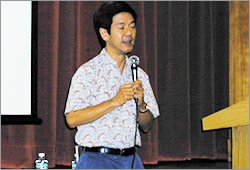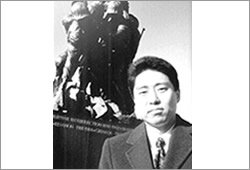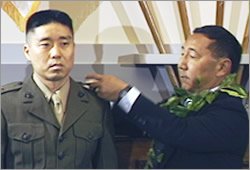YuYu interview Steve Okino
 |
| —— Steve, what brings you all the way from Hawaii to San Diego? Well, it’s a really an important thing that we are doing with the release of our documentary “A Most Unlikely Hero” on public television. We are here as part of the program that is taking place with the thousands of city workers in San Diego, the City Diversity Committee and the City-Wide Diversity Resource Committee and their diversity training. It is a marvelous effort that recognizes the value of diversity and increases our respect for one another across all of these artifi cial lines that have been drawn. It really is such a valuable mission and it was an honor to be part of that. —— And isn’t that what your documentary “A Most Unlikely Hero” is all about: getting past the narrow mindedness of all those outdated and limiting beliefs? Exactly. Let me set up the film very briefly, “A Most Unlikely Hero” is a film and story of one person’s (Bruce Yamashita) five-year fight for justice against all of the odds. In it we documented Bruce’s prolonged legal battle with the Marine Corps for its discriminatory treatment of him during his training in Officers Candidate School (OCS) which led to his subsequent disenrollment; a battle in which he ultimately prevailed. We made it to celebrate the idea of courage and heroism in a little bit different sense than what we normally think of them. It’s a celebration of democracy and a celebration of diversity and it also reinforces the idea that one person, no matter who they might be, can make a difference, stand for change and can succeed. It is really important for us to recognize the notion that the struggles and achievements of one person, no matter which group that person belongs to, Hispanics, Asians, Arab-Americans, whichever, truly are the struggles and achievements of every person and group. That’s key behind the making of this film. Of course now with the global environment being what it is, we are seeing that our civil rights, human rights, and civil liberties are more important than ever and that’s one of the lessons of the film that we hope to convey. —— So Bruce’s struggle was really everyone’s fight for justice and equality? 
Steve, sharing his insights and experiences
Yes, in some sense. Even though this story is rooted in history and steeped with tradition and sacrifices of generations before and it’s about one man of Japanese ancestry from Hawaii, you’ll see the achievement of this one individual really affects us all. Basically, that’s why we have been trotting around the country and even parts of Japan for the last 18 months showing this to anyone who will come in hopes of inspiring somebody. —— How did you first get involved with Bruce? I got involved with Bruce’s case as a member of the Japanese American Citizens League (JACL) in Honolulu when he came to us to ask for help because nobody else would help. Frankly, the reason nobody would help him was not because the facts of the case or what happened to him—it’s because the military, under various Supreme Court rulings, can operate outside all of the equal-opportunity and non-discrimination regulations we all have to abide by. The military is exempt. So, due to my naiveté at that point we decided to take on Bruce’s case thinking, “Well shoot, how hard can it be?” The facts were on our side…so that’s how I got involved. —— As a group were you and the rest of the JACL ready for this kind of fight? We thought so. We had several lawyers on the board and so when Bruce had come in and presented his request it wasn’t long before we voted to accept his case. It was really something that is right up our alley—providing some legal assistance to someone who thought they were discriminated against. We voted to help in anyway we could, particularly legally, and as the legal work continued and as the first affidavit was prepared and the details and the dimensions of the case started to unfold it dawned on us that it was little bit bigger than we had first thought. Later when the Freedom of Information Act request was filed and the statistics came in and the researchers and statisticians that we were working with told us what they had found…we knew that this was not just a little bit bigger—this was potentially landmark case stuff! —— What did the statistics show? Well, they uncovered the secret that was key in bringing Bruce justice. It was a secret that the Marine Corps probably didn’t even realize it was keeping... When we made the Freedom of Information Act request, no one thought, especially Bruce, that we’d find evidence of discrimination beyond what specifically happened to him. But that’s exactly what we found. The data proved that a pervasive, consistent pattern of discrimination existed against minorities at Officer Candidate School for years and years. It was evidence so persuasive that Congress and the White House couldn’t ignore it. When theses findings became key to a “60 Minutes” investigation and the Commandant of the Marine Corps added fuel to the fire by commenting that, “minorities don’t shoot as well as non-minorities...they don’t swim as well, and when you give them a compass and send them on a land navigation exercise, they don’t do as well at that sort of thing either.” Only weeks later, Bruce Yamashita was commissioned as Captain Yamashita, and his case became the catalyst for statutory and procedural reform to prohibit racial and ethnic discrimination in the Marine Corps and in all the branches of the military service. —— When did you realize that this would make a great subject for a documentary? Well, as we got further into the case and we worked with Bruce more and more, we suspected that this case had implications above and beyond just this one person who had beef with the Marine Corps and it dawned on us that maybe this is a story that other people might benefit from and that should be told or at least documented for posterity. So starting in 1991 and 1992 we began shooting some videotape. We’d pass the hat and raise some money and hire a crew to shoot for a day; we’d run out of money and then we’d have to put the tape on the shelf for a year. Every once in a while we’d look at our pockets and see how much change we had…and maybe we’d hire a crew for a half-day. It went on piecemeal like that over the course of several years and little by little we just kept accumulating material. Finally, at some point you have to fish or cut bait, so we did the film. —— Was this a difficult story to tell, especially since you needed some cooperation from the military and you were not exactly portraying them in such a favorable light? I think we portrayed them in a fair light…I mean the facts are out there and they are what they are. The fact that the military uses the finished product for it’s training purposes, I think, says a lot about the fairness and balance that we achieved. This was a particularly hard story to tell, because it is so complicated and it deals with a bureaucratic and an administrative process that is all but indecipherable to a common person. The creative process is always a mystery, but the secret for me is to just get out of the way; let the universe give it to you and it inevitably does. It just takes a lot of trial and error and you go through a lot of paper and you make a lot of mistakes. Every project has its ebbs and flows, excitement and discouragement. —— As the case grew from being about one person to representing the entire minority class, did you receive broader support from various minority groups? Individually…yeah, but more moral support than anything else. Organizationally it was tough because the legal case always revolved around Bruce; it never reached class action status. It was the political, PR and media stuff that just mushroomed, particularly because of the revelations surrounding the statistics. As a result there were a number of groups that helped politically in lobbying and putting pressure on Congress and the White House, but through it all the JACL, locally and particularly nationally, was the lead organization —— Legal battles take an enormous amount of time and money, how did you manage and fund all of this? 
(ABOVE, L-R) Producer Steve Okino, his Marine Corps PR minder, and Bruce Yamashita on the grounds of the Marine Corps Officer Candidate School, Quantico, VA.
It was all done pro-bono and we would do fund raisers from time to time to cover costs. Just getting a hearing transcript is a couple thousand bucks! Then there were all the travel costs to the NDRB hearings and so on. Bruce throws around a figure of anywhere from a half-million to a million dollars to do what was done over those four and a half years. We were constantly surprised by the out flow of support. Local press coverage generated more interest and support, and that support translated into the fundraising efforts. The longer this case went on and the more word got out about it, particularly the word about the stonewalling and delays, the more support we attracted. Once people understood what this was all about they were more than willing to help out. Jim Dannemiller, one of the cofounders of SMS Research, a leading research firm in Honolulu, along with David Takeuchi, who was at UCLA at the time…they’re the ones that did the statistical analysis which made all the difference. —— Were there times you wanted to just call it all quits? Well, what happened during the case strongly parallels what happened in making the film. There where times when we wanted give up on both ends. If we had been more realistic, we probably would have thrown in the towel on any number of occasions. Still, these are the things that sometimes you’ve got to do and see them through. If we don’t do it who’s going to? If you believe there is a story to be told, then at some point you’ve got to bite the bullet and make it. People came forward and did what they could; I don’t want to minimize that, but there was also opposition. There were people that said, “He’s nothing but a whiner and he deserved to be kicked out; he’s a complainer and he’s not tough enough to be a Marine!” One of the writers from the “Rafu” George Yoshinaga basically just wanted him to shut up and go away. So there were voices like that we had to contend with. —— So after everything was said and done, what was the end result? Well, Bruce was commissioned as a Captain in the reserves, not as active duty; that wasn’t an option. It would have been the right thing to do in terms of principle, but not in terms of practicality because there were three things working against him; five years had gone by, he was a lot older and wiser, but more importantly he had been fighting this institution for 5 years. Even if you win, do you really want to go back to the place you have been fighting for so long? As a matter of fact every one of the 12 minorities that were with Bruce at OCS, except for one, were disenrolled. As far as the changes within the military itself, this case caused a major reform. There are now non-discrimination regulations required and in place that affect all branches and all levels of the military, not just OCS. As far as the people responsible for this kind of behavior…careers were affected. Unfortunately, they were the careers of the lower-level enlisted guys…those were the guys that who took the heat for the orders and culture that existed. None of the commissioned guys, as far as we could discover, really suffered adversely. It’s the same thing that happened now with Abu Grave; it’s the enlisted people that are taking the fall for the whole thing. —— What is Bruce Doing now? 
A battle of a different sort; Bruce Yamashita, in front of the Marine Corps War Memorial in Washington D.C.
He’s an attorney; he finally passed the bar on his second attempt, despite the odds. As we know, life changes and plans change. He initially wanted to go into the Marine Corps to serve his country, get some litigation experience as a Marine Judge Advocate General and then go and join a big law firm and make a lot of money, etc. So now he’s an attorney in Washington DC, defending indigent criminals and doing a lot of immigration work, which sort of dovetails into the whole issue of civil rights, civil liberties and human rights, particularly with this whole 2001 Patriot act. —— Has there been any change in the statistics presented in the film? We were given the latest set of statistics at the time which covered 2000- 2001, and what these stats have shown is that, as of yet, there has been no change in terms of promotion, recruitment and retention within the Marines and within the OCS they show that minorities, across the board, are being disenrolled at a significantly statistically higher rate than whites. —— Does that surprise you at all? So there are two ways to look at this: you can say the data shows that nothing has changed. Boo! Hiss! We give up; we’ve done all of this work and it’s still the same old stuff. The other way to look at it is that it takes a few generations to sort of purge the system, until new leadership comes up through the ranks. It’s this new leadership, as it comes up, who will be the ones exposed to the diversity training that is now mandated in all branches of the armed services as a direct result of this case. There are equal opportunity officers, who are now required to be at every military installation worldwide as a direct result of this case, as well as, training programs from the Defense Equal Opportunity Management Institute at Cape Canaveral, FL. While it is not good to see the data from 2000-2001, it is really heartening to know that these things are in place and are working. So as younger officers are promoted and as time goes along and people retire and leave the system we know that there is hope and change will come. I prefer to take the route of hope. —— Is it even more important today than it was then? 
Finishing what he started, Captain Bruce Yamashita at his commissioning ceremony as his 5-year struggle draws to a close.
I’m convinced that it is and I think Bruce is as well. The reason is because of the fragile nature of civil rights and civil liberties plus this new concept of patriotism, which is like sheep following along without questioning. To question or to dissent is unpatriotic in a lot of people’s minds these days and we’re saying that it is the ultimate form of patriotism—to stand up for the beliefs and values and the traditions that this country was founded on and to question those that would infringe upon them. It is tough to stand in the face of criticism, regardless of what it is, but I think the nexus between Bruce’s case and the atmosphere of post 911 is really clear and the implications being that unless people stand up and unless people find that courage within themselves to stand up for real values and what they believe in then…all is lost! What is there left? —— Is there something that working on this project for all those long years has taught you? So I want to leave you with the biggest lesson that Bruce’s struggle taught us, in making this film and working on his case and one that he didn’t even realize he was teaching us…and it goes something like this, you don’t have to have gone to an Ivy League school and you don’t have to have an MBA, you don’t have to live in the best neighborhood, drive the fanciest car, have a high status job or come from a family of wealth and power, riches and fame—in order to make a difference. In order to make changes in this world, large or small, all you need is the belief and the commitment to walk the talk, to live your beliefs. If you can do that, then you can make a difference—it just takes that kind of a commitment. The bottom line is, there’s really an unlikely hero in all of us, each and every one of us. We all have the potential to do that and we hope that this film inspires a little bit of that potential. (07-01-2005 issue, Interviewed by Terry Nicholas) |

